Teenage Pregnancy In the United States
Overview
Teenage pregnancy is defined as a teenage girl usually between the age of 12-19 becoming pregnant.[1] This term refers to girls who have not reached legal adulthood, have not completed her core education (secondary school) or is still financially dependent upon her parents.[2] This topic has received attention and concern from the general public, policy makers, religious leaders and social scientists. [3] Teenage pregnancy is a complex issue with many reasons for concern. [3] Teenage pregnancy is a natural human event that is a poor fit with our modern society. [3] The number of teen pregnancies and the outcomes along with it is a serious social problem. [3] However, this view does not apply to all cultures.
Date and Research: Teenage Pregnancy and Abortion Statistics in the United States
In 2011, women from aged 15-19 gave birth to 553000 pregnancies, for a rate of 52.4 pregnancies per 1000 women in this age group.[4] In 2014, women from aged 15-19 gave birth to 249078 babies. [4]There is a birth rate of 24.2 per 1000 women. [4]Birth rates for women aged 15-19 dropped 9% from 2013, birth rates fell 11% for women aged 15–17 years and 7% for women aged 18–19 years.[4]
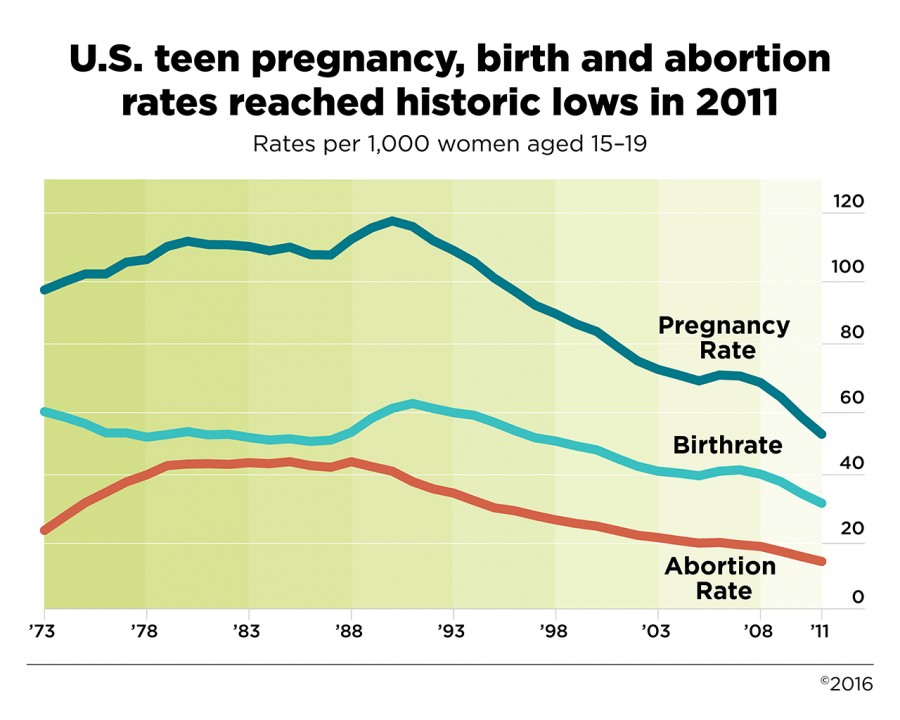
Source: Guttmacher Institute
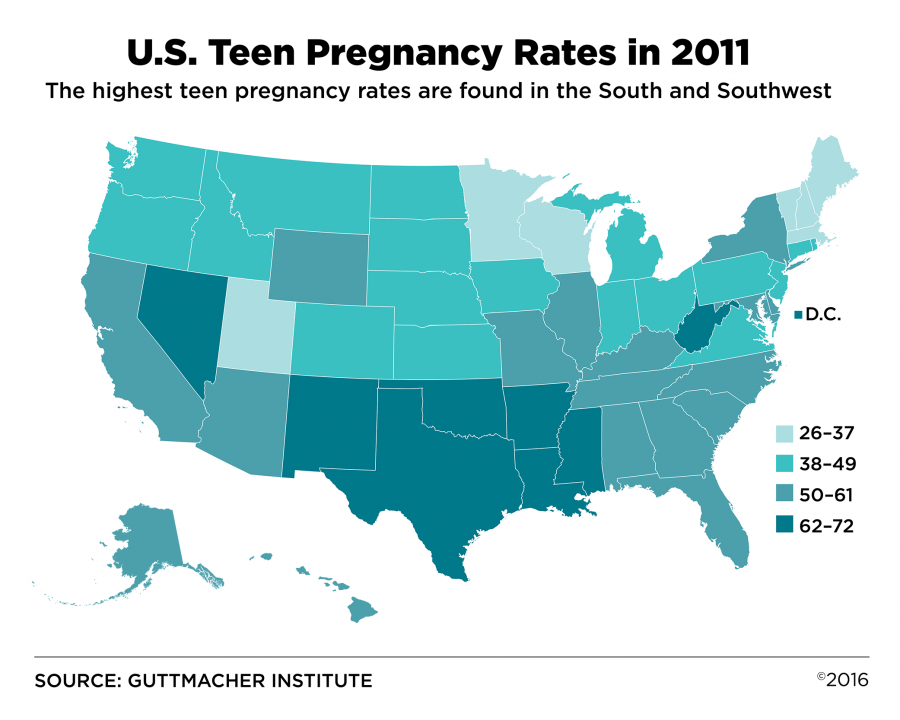
The dropping rates for all races and for Hispanics:
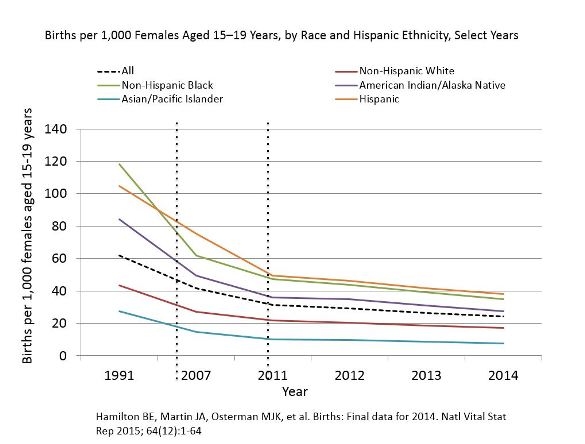
Source: Center for Disease Control and Prevention
- 12% for American Indian/Alaska Natives (AI/AN)[4]
- 11% for non-Hispanic blacks[4]
- 11% for Asian/Pacific Islanders[4]
- 9% for Hispanics[4]
- 7% for non-Hispanic whites[4]
Although birth rates have been dropping in the past decade, the United States teen pregnancy rate is higher than many other western industrialized nations. [4]
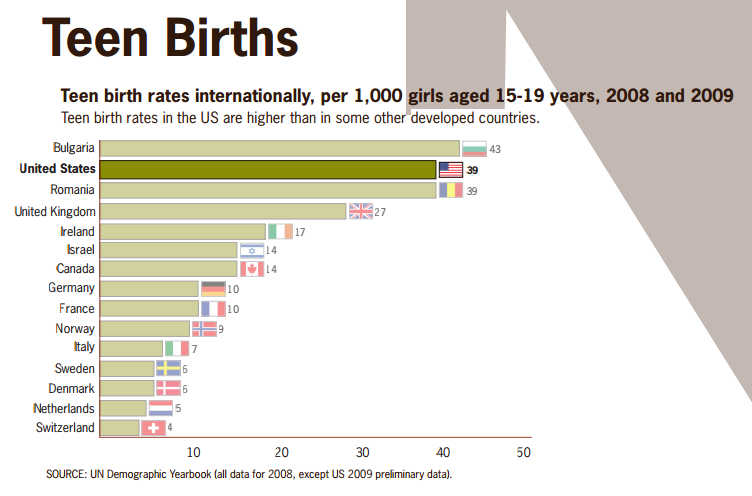
Risks
Teenage pregnancy is an important issue for several reasons. There are health risks for the baby and children born to teenage mothers are more likely to suffer economic, social, emotional and health costs on teen parents and their families.
Consequences Towards the Mother
Teenage births are associated with lower annual income, because teenage mothers are more likely to drop out of school.[5] Without a high school diploma, teenage mothers are more likely to rely on welfare from the government. [5]Teenage pregnancies are also associated with increased rates of alcohol abuse and substance abuse.[5] In the United States, the annual cost of teen pregnancies from lost tax revenues, public assistance, child health care, foster care and involvement with the criminal justice system is estimated to be about $7 billion.
[5]
Prenatal Care
The biggest risk is not getting adequate prenatal care, especially in the first months of pregnancy. [6]This can help monitor the baby’s growth, the mother and also other complications. A lack of prenatal care can cause many complications throughout the process of having a baby.
Premature Birth
Another risk is premature birth and this happens when the premature labor begins too early. This can lead to respiratory digestive, vision, cognitive and other problems. [6]Teenagers have the option to choose abortion, but there are laws and regulation before the procedures.
Low Birth-weight
There can also be a risk of having a low birth-weight baby. The baby is unable to to leave the hospital, because it is too weak. In this case, the baby needs to be put in a ventilator in a hospital's neonatal care unit for help with breathing after birth. [6]
Diseases and Viruses
Also, Teenagers who have sexual intercourse should be safe, because STDs which can be transmitted can affect the growing baby.[6]
Abortion and Legislation
Abortion
Abortion is the term used to describe termination of a pregnancy. [7] This is basically destroying the embryo or fetus before it is capable of independent life. [7]The technique chosen to terminate pregnancy depends on the stage of pregnancy and the laws in the country.
Legal Issues and Regulations
In 1973, the Supreme Court passed down decisions in Roe V. Wade and Doe V. Bolton. [8] Abortion is legal but may be restricted by the states to different degrees. States have passed laws to restrict late term abortions, require parental notification for minors, and mandate the disclosure of abortion risk information to patients prior to the procedure. [8]38 states require an abortion to be performed by a licensed physician.[8] 18 states require an abortion to be performed in a hospital after a specified point in the pregnancy and 18 states require the involvement of a second physician after a specified point.[8] 43 states prohibit abortions to protect women’s life or health. [8]
Key Factors
Some of the key factors are living in poverty, having difficult economic living conditions, having a lack of educational achievement, having a mother who gave birth before the age of 20, being from a single-parent home, living in a home with frequent family conflict, early sexual activity, early use of alcohol and drugs, low self-esteem and an individual’s race and ethnicity can be a risk factor for teen pregnancy. [9] All these factors are possibilities of repeating cycles occurring. The repeating cycles are basically the older generation's conditions passing on to the future generations.
Prevention
There are many ways to prevent teenage pregnancy and individuals should be aware of what can be done. Parents, educators, public health and medical professionals, and community organizations all have a role to play in reducing teen pregnancy. It is necessary to understand the risks and protective factors in order to appropriately implement prevention efforts. [9]
Teenagers
Teenagers can always choose not to have sex until they are capable to take the responsibilities of being parents.[10] They can talk with healthcare providers about using birth control if they choose to be sexually active. [10]
Federal Government
One of the most important way to prevent teenage pregnancy is to be educated. There are recommended government programs that reach teens that have been proven to work, help parents communicate with their teens and improve sexual and reproductive health services.[10] The federal government can provide affordable family planning services to support families in need. [11]They can develop clinical guidance and evaluating programs in communities for safe and effective use of birth control. [11]
Parents, Guardians and Caregivers
Parents, guardians and caregivers should talk to their teenagers about the importance of sexual and reproductive health, no matter female or male.[10] Teenagers need to understand the responsibility lies between both boys and girls for avoiding teen pregnancy. Parents can always Check with their health plans about coverage of preventive services. [11]Birth control and counseling may be available for teens at no cost. [11]
Doctors, Nurses and Other Health Care Providers
In the society, there are health care providers that are friendly and culturally appropriate that offer services for sexual and reproductive health. [10]Communities can promote adolescent development programs in or after school to teach life skills and for them to make smarter choices. These can be presented to teenagers and also teenagers that are already pregnant. They can encourage teenagers to use effective birth control and condoms to prevent sexually transmitted diseases. [11]
There are many ways to prevent pregnancy:
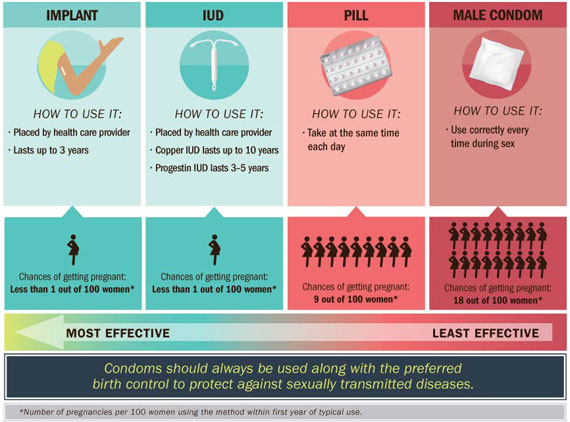
Source: Center for Disease Control and Prevention
The Center for Disease Control and Prevention has a Vital Signs program that teaches teenagers the current issues and the many ways to prevent it.
For more information:
http://www.cdc.gov/vitalsigns/teen-pregnancy.html
Conclusion
Despite the dropping rates of teen pregnancies, there are still work to be done, because teen pregnancy has such a huge impact on the future of America’s children. Demographic data continue to report that in developed countries such as the United States, teenage pregnancy causes lower educational achievement, increased rates of economic problems and worse outcomes for children of teenage mothers compared to children of young adult women. The concerns and discussions about teenage pregnancy is based on the impact that teenage pregnancy can have on the lives of the girls and their children.
References
- ↑ UNICEF Malaysia Communications. (2008). Young People and Family Planning: Teenage Pregnancy. Retrieved from http://www.unicef.org/malaysia/Teenage_Pregnancies_-_Overview.pdf
- ↑ Segen’s Medical Dictionary. (2012). Teenage pregnancy. Retrieved from http://medical-dictionary.thefreedictionary.com/teenage+pregnancy
- ↑ 3.0 3.1 3.2 3.3 Andrew L. Cherry & Mary E. Dillon. (2015). Teenage Pregnancy. Retrieved from Oxford Bibliographies website: http://www.oxfordbibliographies.com/view/document/obo-9780199791231/obo-9780199791231-0111.xml
- ↑ 4.0 4.1 4.2 4.3 4.4 4.5 4.6 4.7 4.8 4.9 Center for Disease Control and Prevention. (2016). Reproductive Health: Teen Pregnancy. Retrieved from http://www.cdc.gov/teenpregnancy/about/
- ↑ 5.0 5.1 5.2 5.3 Remedy’s Health Communities. (2015). Teenage Pregnancy, Consequences of Teenage Pregnancy. Retrieved from: http://www.healthcommunities.com/teen-pregnancy/children/overview-of-teen-pregnancy.shtml
- ↑ 6.0 6.1 6.2 6.3 WebMD. (2016). Teenage Pregnancy: Medical Risks and Realities. Retrieved from http://www.webmd.com/baby/guide/teen-pregnancy-medical-risks-and-realities?page=2
- ↑ 7.0 7.1 Segen’s Medical Dictionary. (2012). Abortion. Retrieved from http://medical-dictionary.thefreedictionary.com/teenage+pregnancy
- ↑ 8.0 8.1 8.2 8.3 8.4 Guttmacher Institute. (2016). An Overview of Abortion Laws. Retrieved from: https://www.guttmacher.org/state-policy/explore/overview-abortion-laws?gclid=CjwKEAjwkui7BRCf64DNtfDupgoSJAA_0LOoMX_frbHFYAlAvKF5qIRdga-4mw5-Q0uq6DwIhF4uGhoC5ijw_wcB
- ↑ 9.0 9.1 Youth.GOV. (2016). Risks and Protective Factors. Retrieved from http://youth.gov/youth-topics/teen-pregnancy-prevention/risk-and-protective-factors
- ↑ 10.0 10.1 10.2 10.3 10.4 Center for Disease Control and Prevention. (2016). Preventing Teen Pregnancy in the US. Retrieved from http://www.cdc.gov/vitalsigns/pdf/2011-04-vitalsigns.pdf
- ↑ 11.0 11.1 11.2 11.3 11.4 Center for Disease Control and Prevention. (2016). Preventing Teen Pregnancy in the US. Retrieved from http://www.cdc.gov/vitalsigns/larc/index.html